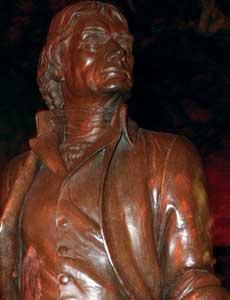By Julia Matias
A lack of diversity on campus, especially when it comes to representation of African-American leaders through campus statues, has been a topic of concern in Student Government Association elections for two years.
With encouragement from SGA vice-president Grant Parker and various organizations, senator Josh Lanier wrote a referendum to promote a more culturally aware environment on campus.
The University predominantly displays white, male historical statues, which senators think misrepresent the student body. Although the University has several female mythical figures, some senators do not see them as appropriate symbols of the community.
“These are not suitable historical figures,” Lisa Giunta, a junior history major and SGA senator, said. “We need reminders of how ordinary people can make a difference, not mythical people.”
Inspired by the organization Independent People’s Democratic Uhuru Movement’s (inPDUM) previous efforts to remove the Thomas Jefferson statue, Lanier is presenting his referendum to the senate on April 4.
InPDUM was a former African-American student organization that was active two years ago. Observing that Thomas Jefferson was a slaveholder, the organization wrote a referendum and fought for the removal of the statue. The referendum lacked enough support from students and failed, Lanier said.
“I later came to regret not being supportive as I became more educated with their ideas and influences,” Lanier, a junior economics and philosophy major, said. “I realized that every group of people ought to have some form of inspiration to look up to.”
Parker, who began speaking to clubs and University President Stuart Rabinowitz about the statues in February of last year, convinced senators such as Lanier and Giunta to take further steps.
“I feel so passionate about this now,” Giunta said. “We do need to expand the University culturally and have a broader perspective of the world.”
However, the removal of any statue is difficult and would require too many procedures. Therefore, Lanier thought the best and easiest way to approach the problem is by adding statues.
“In a free country, you have to let other cultures show their symbols and their contributions,” Miguel-Angel Zapata, an associate professor of Latin American literature, said. “One of the ways to show this is by having monuments of them. Therefore, it is absolutely necessary to have statues representing minorities.”
Lanier continued Parker’s survey of organizations such as the African People’s Organization (APO) and Hofstra’s Organization of Latin Americans (HOLA) to find positive images from history. The four names that frequently came up and appear on the referendum are Rosa Parks, Frederick Douglas, Malcolm X and Simon Bolivar.
Lanier said University support for the plans depends on which of the four figures the student body chooses.
“Obviously some of the figures are more controversial than others,” he said. “Who the students pick will depend on the level of support we expect to get from the University.”
If the majority of the student body votes for the referendum, SGA is given the power to push forward to convince the administration that the University needs a more diverse atmosphere.
“Obviously, any referendum by the Student Government Association gets serious consideration and deserves study,” Melissa Connolly, vice president of University Relations, said.
The referendum would have to be brought to the dean of students for approval, to both the Provost’s Committee on Honorary Degree Candidates and director of the University Museum for consideration, and then to Rabinowitz, Connolly added.
Although it may take until the next academic year for his plans to take action, Lanier does not doubt it will happen.
“I’m a firm believer that all the power rests on the students,” he said. “It just depends on whether that power is realized or not. I don’t doubt if it’s possible.”

Proposed SGA referendum gives students a chance to weigh in on new campus figures.
